
Meliaceae, the mahogany family, is a flowering plant family of mostly trees and shrubs in the order Sapindales.

Antidesma is a genus of tropical plant in the family Phyllanthaceae formally described by Linnaeus in 1753. It is native to tropical Africa, S + E + SE Asia, Australia, and various oceanic islands. The greatest diversity occurs in Southeast Asia.

Mallotus is a genus of the spurge family Euphorbiaceae first described as a genus in 1790. Two species are found in tropical Africa and Madagascar. All the other species are found in East Asia, the Indian Subcontinent, Southeast Asia, eastern Australia, and certain islands of the western Pacific. The genus has about 150 species of dioecious trees or shrubs.

Bridelia is a plant genus of the family Phyllanthaceae first described as a genus in 1806. It is widespread across Africa, Australia, southern Asia, and various islands of the Indian and Pacific Oceans.
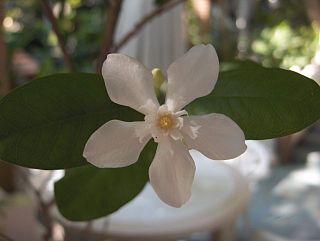
Wrightia is a genus of flowering plants in the family Apocynaceae, first described as a genus in 1810. It native to tropical Africa, China, the Indian Subcontinent, Southeast Asia, Papuasia, and Australia. The species are all small trees or shrubs.
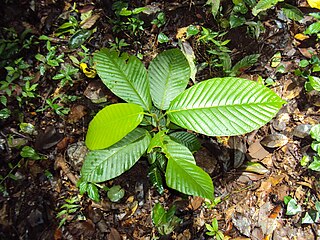
Dipterocarpus is a genus of flowering plants and the type genus of family Dipterocarpaceae.
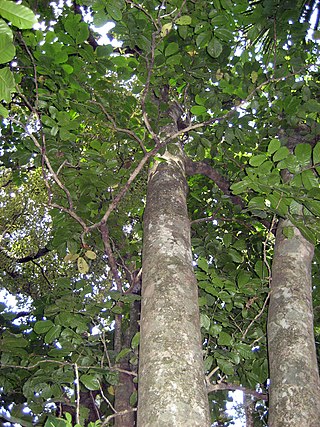
Dysoxylum is a flowering plant genus of trees and shrubs from the mahogany family, Meliaceae.

Actinodaphne is an Asian genus of flowering plants in the laurel family (Lauraceae). It contains approximately 125 species of dioecious evergreen trees and shrubs.
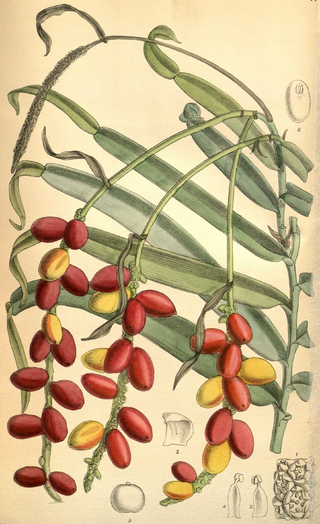
Pothos is a genus of flowering plants in the family Araceae. It is native to China, the Indian Subcontinent, Australia, New Guinea, Southeast Asia, and various islands of the Pacific and Indian Oceans.
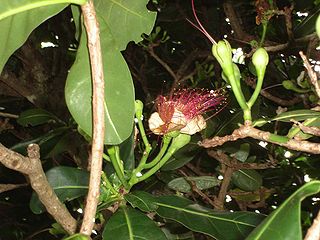
Barringtonia is a genus of flowering plants in the family Lecythidaceae first described as a genus with this name in 1775. It is native to Africa, southern Asia, Australia, and various islands of the Pacific and Indian Oceans. The genus name commemorates Daines Barrington.
Pseudocarapa is a genus of flowering plants in the family Meliaceae. It includes five species which range from Sri Lanka to Sumatra, Peninsular Malaysia, Borneo, and New Guinea.

Themeda is a genus of plants in the grass family native to Asia, Africa, Australia, and Papuasia. There are about 18 to 26 species, many of which are native to Southeast Asia.

Didymocheton is a genus of flowering plants in the family Meliaceae. It includes 41 species which range from eastern India through Indochina and southern China to Malesia, Papuasia, eastern Australia, New Zealand, and the South Pacific.
Goniocheton is a genus of flowering plants in the family Meliaceae. It includes four species which range from Indochina to south-central China, Taiwan, Malesia, Papuasia, Vanuatu, and Queensland.

Chisocheton is a genus of trees in the family Meliaceae. The genus name comes from the Greek schizos and chiton meaning "split tunic", referring to the lobed staminal tube of C. patens. Their range is from India and tropical China, throughout Malesia and south to New South Wales and Vanuatu.
Prasoxylon alliaceum is a tree in the family Meliaceae. The specific epithet alliaceum is from the Latin meaning "onion-like", referring to the smell of the inner bark.

Dysoxylum parasiticum, commonly known as yellow mahogany, is a species of rainforest tree in the family Meliaceae native to Taiwan, parts of Malesia, Papuasia, and northeast Queensland.
Dysoxylum excelsum is a tree in the family Meliaceae. The specific epithet excelsum is from the Latin meaning "tall".
Epicharis is a genus of flowering plants in the family Meliaceae. It includes seven species which range from Indochina to south-central China, Taiwan, Malesia, Papuasia, Queensland, and Fiji.











